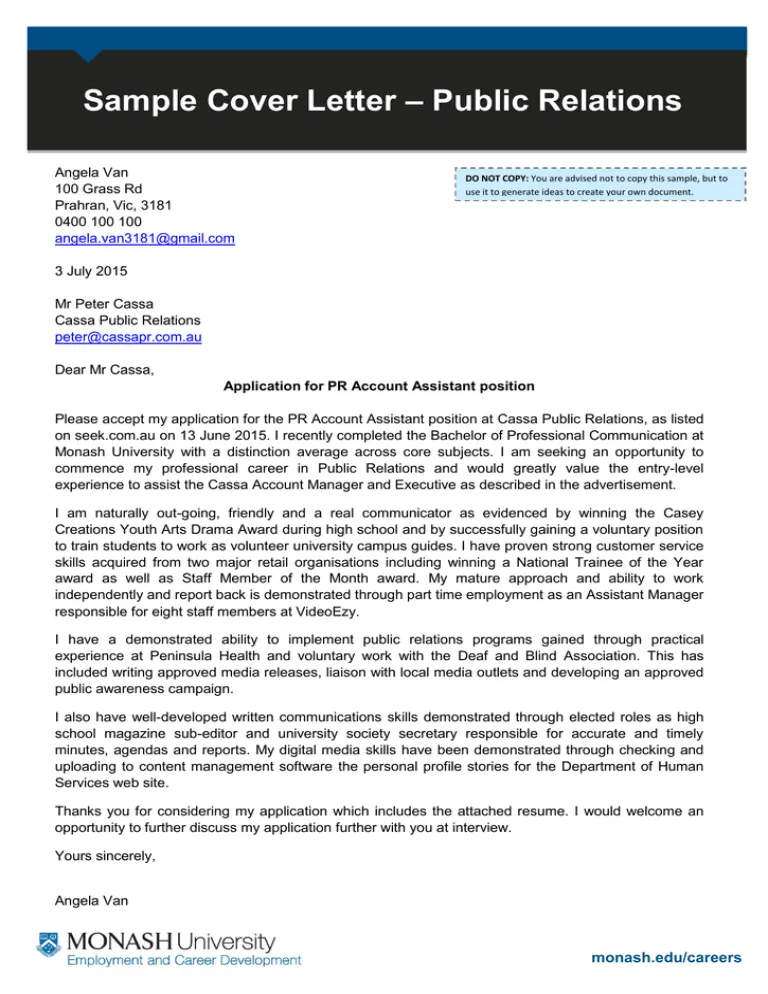Understanding the Power of a PR Cover Letter
A well-crafted PR cover letter is your first introduction to a potential employer. It’s your chance to make a strong first impression and set yourself apart from other candidates vying for the same public relations job. Unlike a resume, which provides a factual overview of your experience and skills, a cover letter allows you to showcase your personality, express your enthusiasm, and demonstrate how your qualifications align with the specific requirements of the role and the company’s values. Think of it as your personal brand statement, a document that breathes life into your application and convinces the hiring manager that you are the perfect fit. It’s not just a formality; it’s a strategic tool to open doors to opportunities and elevate your career prospects. Therefore, making the cover letter powerful is the key to success.
Why a Great Cover Letter Matters
In the competitive field of public relations, where communication and storytelling are paramount, a poorly written cover letter can be a deal-breaker. A great cover letter demonstrates your writing proficiency, your ability to articulate your thoughts clearly and concisely, and your understanding of the PR landscape. It enables you to tell a compelling narrative that highlights your accomplishments and aligns them with the company’s needs. It shows you’ve invested time and effort in understanding the role and the organization, signaling your genuine interest. Moreover, it allows you to address any potential gaps in your resume and offer context for your career trajectory. A strong cover letter conveys professionalism, attention to detail, and a proactive approach – all highly valued qualities in a PR professional. A great cover letter is the key to land the job.
Targeting Your Application
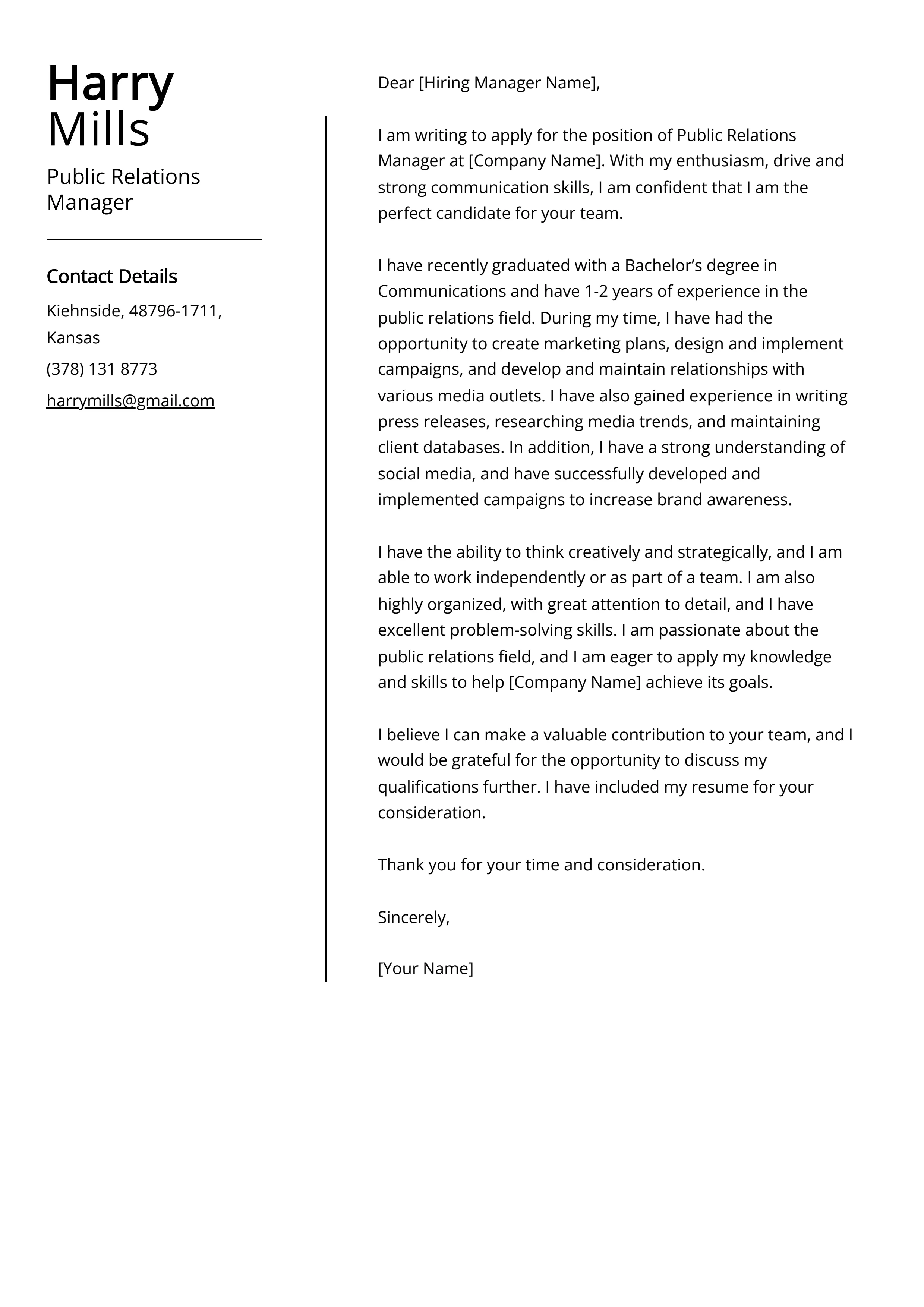
The key to a successful cover letter is to target each application, avoid generic templates. Your goal is to make it clear that you are addressing the particular job in question. A generic cover letter feels impersonal and is less likely to resonate with the hiring manager. Always customize your letter to the specific role and company. Begin by carefully researching the company and thoroughly analyzing the job description to identify the key requirements, skills, and values they’re seeking. Then, tailor your letter to directly address these points, highlighting your relevant experience, accomplishments, and the value you bring to the organization. Mention specific projects, initiatives, or situations where you demonstrated those skills and achieved positive outcomes. Show you’ve taken the time to understand their needs, and you are the best fit for the role.
Researching the Company
Before you even begin writing, dedicate time to thoroughly research the company. Visit their website, explore their social media profiles, read recent press releases, and analyze their industry presence. This will give you insights into their brand, values, and recent projects. Understanding their current challenges and successes allows you to tailor your cover letter to demonstrate how your skills can help them achieve their goals. Showing this knowledge impresses the hiring manager because it shows that you are genuinely interested in the company. Identify their target audience, their communication style, and any ongoing campaigns. This research will also provide you with the necessary information to personalize your cover letter and demonstrate your understanding of the company’s goals.
Analyzing the Job Description
The job description is your roadmap. Read it carefully, multiple times. Highlight the key requirements, skills, and responsibilities mentioned. Identify the keywords and phrases used to describe the ideal candidate. Then, compare these requirements to your own skills and experience. Think of examples from your past work experience that prove you have the skills they are looking for. Tailor your cover letter to mirror these requirements, using the same language and providing concrete examples of how you’ve demonstrated those skills in the past. Be sure to address all the essential criteria and demonstrate how your qualifications align with the role’s expectations. This targeted approach ensures your application is relevant and grabs the hiring manager’s attention immediately.
Crafting a Compelling Opening
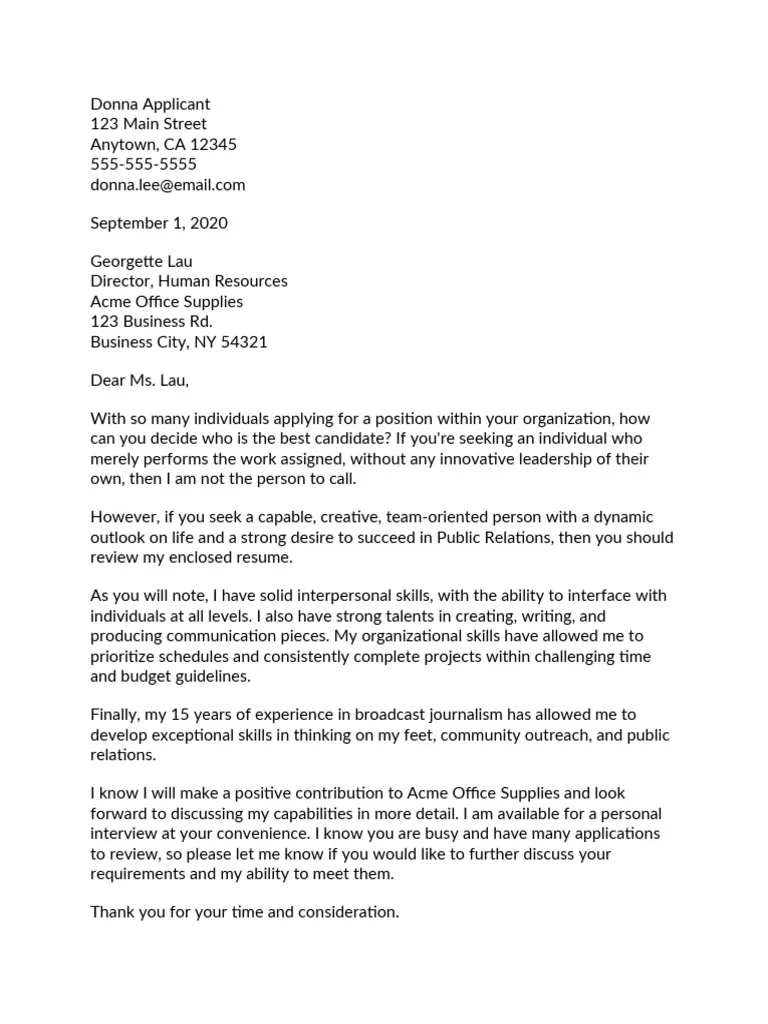
The opening paragraph is your hook; it sets the tone for your entire cover letter. Instead of a generic greeting, aim for an engaging opening that grabs the reader’s attention immediately. You can start with a brief statement of your interest in the role and the company. Make your introduction short, clear, and enthusiastic. Demonstrate your knowledge of the company and mention something that caught your attention, like a recent campaign or achievement. Alternatively, you can start with a relevant achievement or a compelling anecdote that highlights your skills and enthusiasm. Avoid clichés and aim for a personalized approach that shows your genuine interest in the position. The opening should immediately convey your value, demonstrating why you are the ideal candidate for the public relations job. The goal is to make them want to read the rest of the letter.
Highlighting Relevant Experience
This section is about demonstrating how your experience aligns with the role’s requirements. Choose the most relevant experiences from your resume. Don’t just list job titles and responsibilities; provide specific examples of your achievements and the positive outcomes you delivered in previous roles. Use the STAR method (Situation, Task, Action, Result) to structure your examples, which will showcase your problem-solving capabilities, the steps you took, and the tangible results you achieved. Focus on experiences that align with the key requirements outlined in the job description. Quantify your accomplishments whenever possible by using numbers and metrics to illustrate your impact, such as increased media coverage, improved brand awareness, or successful campaign outcomes. Tailor each experience to demonstrate the specific skills and qualities the employer seeks.
Showcasing PR Skills and Achievements
Public relations is a skill-based field, so highlighting your specific PR skills is vital. Focus on the skills mentioned in the job description, such as media relations, content creation, crisis communication, social media management, event planning, or stakeholder engagement. Back up your skills by providing examples of how you have utilized them in past projects. Describe a situation where you successfully managed a media campaign, developed compelling content, or handled a crisis. The achievements should be clearly quantified. Showcasing tangible results is important; for instance, you can say that you increased media coverage by a certain percentage or generated a specific number of leads through social media campaigns. Show your capacity for innovation and creativity and show you understand the most effective tools to perform the job. Use action verbs, such as ‘developed,’ ‘managed,’ ‘implemented,’ and ‘achieved,’ to make your accomplishments stand out and demonstrate your capabilities.
Quantifying Your Accomplishments
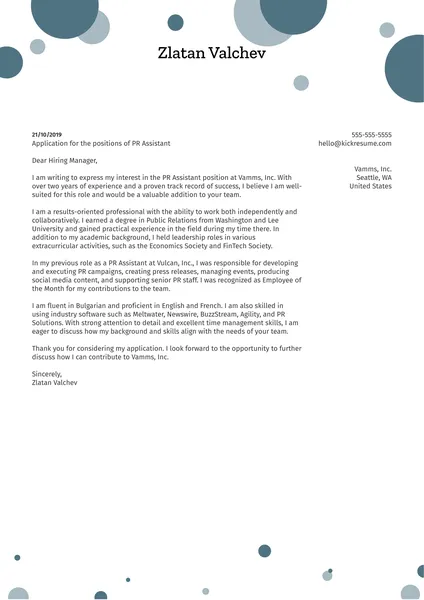
Numbers and metrics make your accomplishments more compelling and demonstrate your impact. Instead of just saying you ‘increased brand awareness,’ specify by how much. Instead of saying you ‘managed social media,’ provide data on follower growth, engagement rates, or website traffic generated. Quantifiable results are convincing and show your ability to drive tangible results. Use metrics to highlight your success in media relations, such as the number of placements secured or the reach of those placements. When describing content creation, specify the number of articles, blog posts, or social media posts created and their performance metrics. Whenever possible, include data on the reach, engagement, or conversions generated by your campaigns. Using data enhances credibility, helps the hiring manager understand the positive impact of your work, and sets you apart from other applicants.
Tailoring to the Job Description
Customization is key. Don’t send a generic cover letter. Tailor each letter to the specific job description and company. Your goal is to demonstrate that you understand the role’s requirements and the organization’s needs. Align your skills, experiences, and accomplishments with the key responsibilities and qualifications outlined in the job description. Use the same keywords and phrases used in the job posting to ensure your application passes the Applicant Tracking Systems (ATS) and catches the hiring manager’s attention. Mention any specific projects or initiatives that align with the company’s goals. Tailoring your cover letter demonstrates your interest, attention to detail, and willingness to invest the time and effort to show you are the right fit. Show you are not just a generic applicant; you are the right person.
Demonstrating Your Value
Show, don’t tell. Instead of simply stating you are a ‘good communicator,’ illustrate this with examples. Provide examples of successful projects and campaigns that demonstrate your value. For example, describe how you used communication skills to resolve a crisis, secure media coverage, or build relationships with stakeholders. Explain how your skills can benefit the company and address their specific needs. Show how your experience and skills align with the role’s responsibilities, highlight how you can make a significant contribution to the organization. Always focus on the value you bring to the table. Consider the hiring manager’s perspective: How can you make their job easier and contribute to the company’s success? When describing past achievements, focus on the outcomes that benefited your previous employers and that show your potential to do the same for the company you are applying to.
Writing a Strong Closing
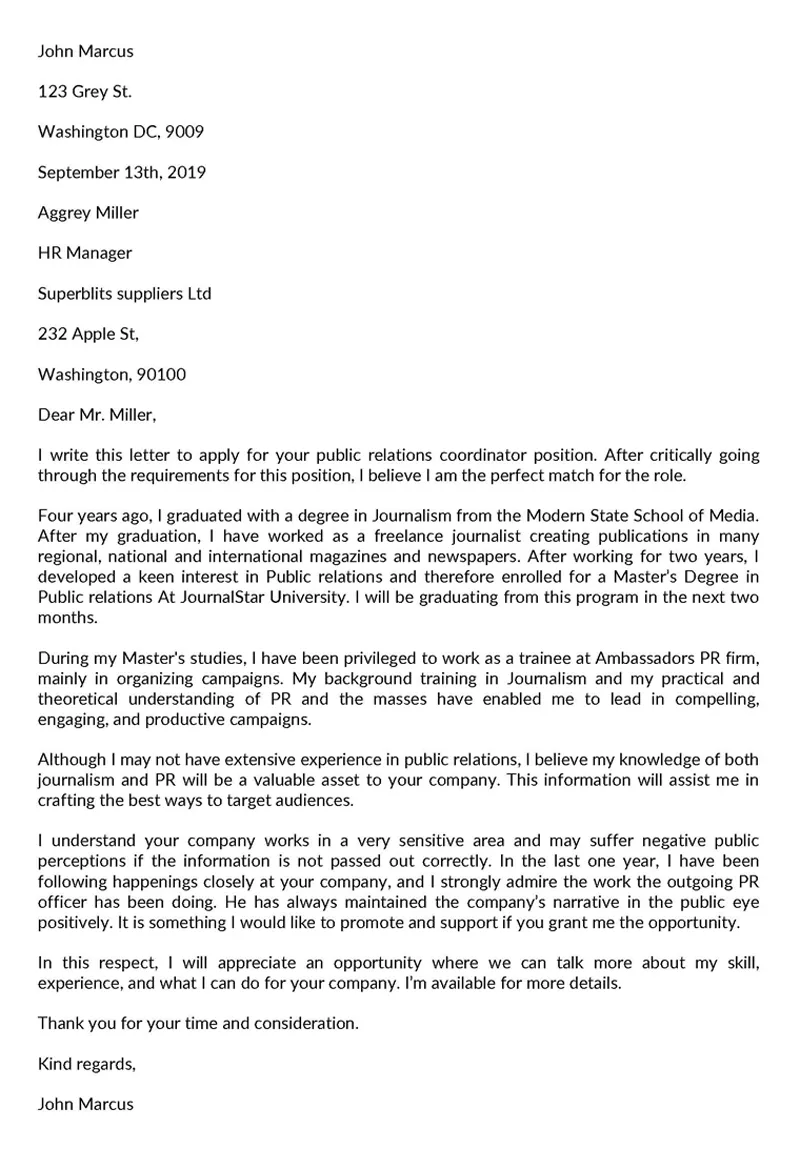
The closing paragraph is your last chance to make an impression. A strong closing should reaffirm your interest in the role and the company. Summarize your key qualifications, emphasizing how your skills and experience align with the role’s requirements. Express your enthusiasm for the opportunity and reiterate your understanding of the company’s goals. Avoid generic phrases like ‘Thank you for your time and consideration.’ Instead, use a more proactive and engaging closing. State your desire for an interview and suggest a specific time or format for a follow-up. If possible, customize the closing by referring to something you learned during your research or a specific aspect of the job that excites you. A compelling closing leaves a lasting impression and encourages the hiring manager to take the next step.
Expressing Enthusiasm and Interest
Show genuine enthusiasm for the position and the company. This demonstrates that you are truly interested in the opportunity and not just sending out a generic application. Show this enthusiasm by mentioning something specific that excites you about the role or the company, for example, a particular project, initiative, or the company’s culture. Express your excitement about the opportunity to contribute to their mission. Avoid generic statements and be specific. The enthusiasm must be genuine. Refer back to your research, mentioning a specific campaign or project that aligns with your skills. This shows that you have taken the time to get to know the organization and are truly invested in the opportunity. Your eagerness is what you make you stand out in the applicant pool.
Proofreading and Editing
Proofreading and editing your cover letter is critical. Errors can ruin your chances, no matter how impressive your skills are. Typos, grammatical errors, and formatting inconsistencies can make you look careless and unprofessional. Carefully proofread the cover letter at least twice. Read it aloud to catch any awkward phrasing or errors that you might miss when reading silently. Have a friend, colleague, or mentor review your cover letter to identify any mistakes. Pay close attention to grammar, punctuation, spelling, and sentence structure. Always use a spell checker and grammar checker, but don’t rely solely on these tools; they can miss subtle errors. Make sure the language is clear, concise, and error-free. A polished cover letter shows attention to detail, professionalism, and respect for the hiring manager’s time. The extra effort will pay off.
Ensuring Professionalism
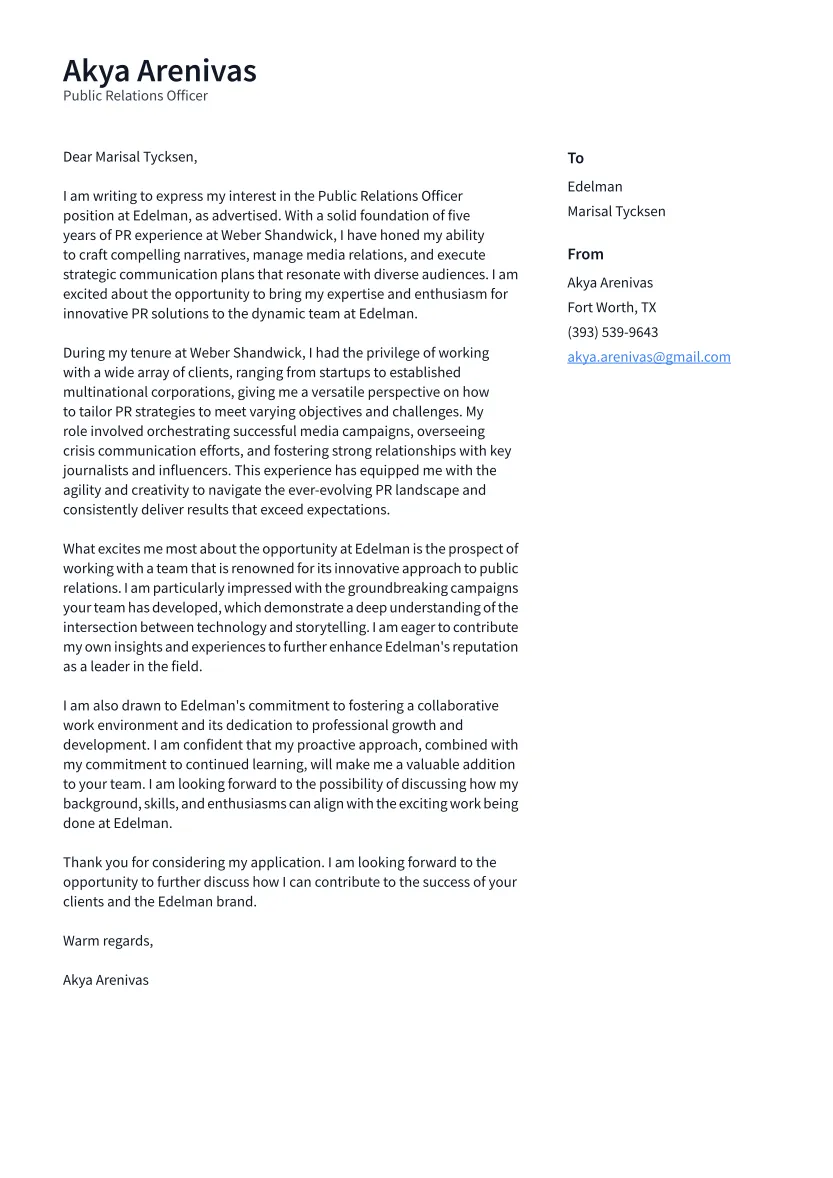
Professionalism is key. Use a formal and professional tone throughout your cover letter. Address the hiring manager by name. Use a professional email address and maintain a formal salutation and closing. Always avoid slang, jargon, or informal language. Choose a professional font, like Times New Roman, Arial, or Calibri, and ensure the font size is easy to read. Maintain consistent formatting throughout the document. Keep the cover letter concise. It should be no more than one page. Ensure a clean, organized layout. Avoid using excessive colors, graphics, or unnecessary embellishments. The goal is to communicate clearly, concisely, and professionally, demonstrating your writing skills and attention to detail. The cover letter reflects you, so make it look professional and elegant. It is the key to win the job.
Formatting Your Cover Letter
Formatting plays a significant role in making a good impression. Keep the cover letter clean, organized, and easy to read. Use a standard business letter format, including your contact information, the date, the hiring manager’s name and title, and the company’s address. Use a clear and professional font, such as Times New Roman or Arial, with a font size of 11 or 12 points. Use single-spacing with a space between paragraphs to make it easy on the eyes. Ensure consistent margins and use bullet points to organize key information. If you are submitting the cover letter as a PDF file, make sure the formatting remains consistent across different devices. The right formatting reflects your attention to detail and helps the hiring manager easily scan your application. Good formatting increases readability and showcases professionalism.
Choosing the Right Font and Style
Choose a professional and easy-to-read font and style. The font you choose communicates your professionalism and attention to detail. Fonts like Times New Roman, Arial, and Calibri are popular and widely accepted. Avoid overly ornate or creative fonts that could distract from the content. Keep the font size between 11 and 12 points for easy readability. Ensure your formatting is consistent throughout the document. Use a standard business letter format with clear headings and subheadings to organize the information. A well-formatted cover letter demonstrates professionalism and attention to detail. A clean, readable font and layout ensure that your message is easily understood and makes a good first impression.
Submitting Your Cover Letter
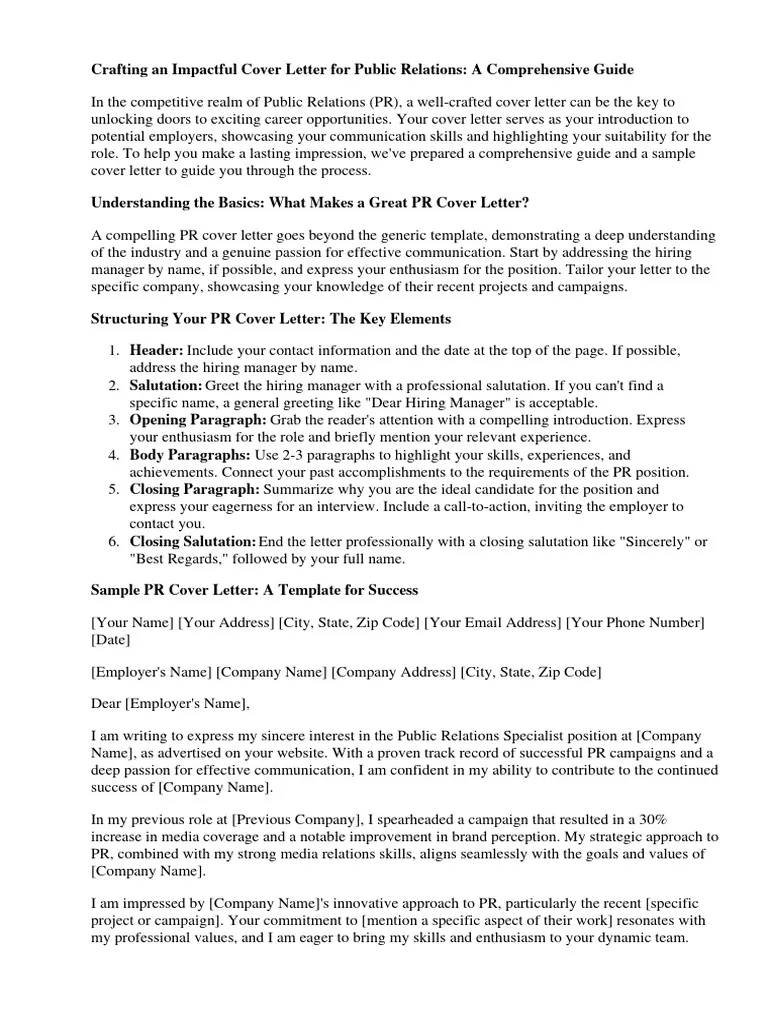
Carefully follow the application instructions provided by the employer. Most employers prefer digital submissions, so save your cover letter as a PDF file to preserve the formatting and ensure it is viewable on any device. Always name your file with your name and the job title (e.g., “JohnDoe_PRSpecialist_CoverLetter.pdf”). If the job description specifies a particular way to submit your application, follow those instructions precisely. Some applications might require you to paste your cover letter into an online form or upload it to a specific platform. Proofread your email before sending, and make sure to address the hiring manager by name. Double-check your attachments to make sure you’ve included the correct documents. Following the submission guidelines demonstrates your attention to detail and your respect for the employer’s process, which can significantly impact your chances of being hired.
